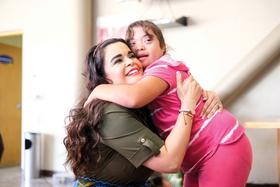Co-teaching is an inclusive education model in which students with special education needs are provided the opportunity to learn in a mainstream classroom with the additional support of a special education teacher who co-teaches with the general education teacher. This model has proven successful in many school districts for several reasons.
Benefits for students with special education requirements
First of all, the co-teaching model ensures that students with special needs have access to the general education curriculum. By law students with disabilities must be provided access to learning opportunities that do not restrict their ability to progress in a subject or grade level. In a co-taught class, special education students have the opportunity to move from modified assignments to typical assignments as they develop skills and confidence. As a result, co-taught special education students are generally more likely to meet grade-level standards.
While they have access to the mainstream curriculum, co-taught students also continue to receive specialized instruction. Special education teachers within the mainstream classroom can coach students individually, or in small groups, providing them the additional coaching and guidance necessary for them to complete activities and assignments.
Differentiated instruction
In addition to in-class support for mainstream assignments, co-taught students also have the opportunity to grow within the curriculum through differentiated instruction. Since there are two teachers in the class, the same material can be taught in two or more different ways. The special education teacher can anticipate student needs and, in planning lessons with the mainstream teacher, prepare alternative lesson materials and assessments to help special education students reach the grade-level learning goals.
Although the special education teacher in a co-taught class often delivers content, he or she sometimes spends class time observing students with special needs. In observing how the student responds to class assignments the special education teacher can develop new ways to revise materials or reteach concepts to ensure every student remains on-task and on-topic. In addition, in large or difficult to manage classes, either of the co-teachers can circulate during a lesson to ensure every student is on-task and attentive, and answer questions or redirection where necessary.
Co-teaching models
- One teaches/one observes: In one model, one teacher delivers a lesson while the other observes and assists students. This model is particularly valuable for topics that are detailed or require the delivery of extensive content such as dates, names, and timeline events. As one teacher explains new ideas, the other reviews student notes to ensure all students are capturing the most important information.
- Parallel teaching: Students are divided into two groups and each teacher delivers the same content in similar or dissimilar lessons to their groups. This model is valuable when co-teachers have identified different learning needs in a classroom that can be addressed through different types of lessons. So, for example, one group may read passages or listen to a teacher lecture, while the other watches a video and copies notes from a board. At the end of the class period, both groups will have received the same information.
- Station teaching: Station teaching tends to be very popular with students, as it gives them the opportunity to move around the classroom and work with different peers. During station teaching class desks are grouped into four or five different areas. Two will be “staffed” by the co-teachers who deliver content directly to students or check their progress on assignments. The other stations call for independent or group work. At the end of the class, students have the opportunity to meet with one or both teachers to review what they’ve learned.
- Team teaching: This model gives all students to learn from two different teachers, who may have different perspectives, methods, or information to share. In team-taught lessons, the entire class is in one group. However, if students fall behind or seem to struggle with the content, one of the teachers can pull a small group away to reteach and review material.
Disadvantages of co-teaching
Obviously, there are many advantages to co-teaching. Students have more opportunities to learn, seek clarification, and receive remediation when there are two qualified educators present during class time. There are, however, some disadvantages to co-teaching environments.
- Concerns for typical students: While co-teaching is well suited to meet the needs of students who require extra support, or those who may need enrichment, there is always the possibility that typical students with average ability and average engagement can be neglected. When a class includes students with special needs, it can be challenging to address the needs of students who meet but do not exceed grade-level requirements. Students who find the content accessible may not seek attention and may develop unrealistic impressions of their own abilities. This model can, potentially, stifle the most typical student who does not seek opportunities to excel.
- Distractions: Some students may be distracted by having two teachers in the classroom, especially if the co-teachers follow a model when just one teacher presents content at a time. A teacher circulating around the classroom during a lesson can capture the attention of easily-distracted students or cause self-conscious students to withdraw from class discussions.
- Student impressions of teachers: If co-teachers follow the model of having one teacher circulate while the other teaches the lesson, students may develop the opinion that one teacher, the one presenting the lesson, has more authority or is more competent than the other. This attitude can be an obstacle to using other co-teaching models, as students may feel slighted if assigned to the less-active teacher during station or parallel teaching.
- Student expectations: Students may react so positively to the benefits of having a circulating teacher available to respond to questions that they may come to expect one-on-one tutoring or re-teaching during class time. This expectation interferes with students’ ability to become independent learners and can lead to them becoming insecure and second-guessing their work, as they are accustomed to having a teacher suggest that they review certain questions or responses.
- Classroom noise: When two teachers are working with students simultaneously, the room will be unavoidably loud. Some students may find it difficult to concentrate and work independently while others are working with teachers. Effective co-teachers work to develop procedures that allow independent students to migrate to a quiet area of the room while others work with teachers. However, being separated from other students can cause students to feel anxious or left out of class activities.
This video explains the co-teaching model for special education.
Despite these manageable drawbacks, co-teaching has proven an effective strategy for integrating students with special needs into mainstream classrooms, and for providing typical students with additional support and enrichment activities. Since co-teaching is a relatively new approach to meeting the needs of special education students, no broad studies have been completed on the effectiveness of this method. However, limited studies show that teachers and students report that co-teaching is effective. Students report that they are able to garner and retain more content in a co-taught course than in a typical mainstream course or in a modified curriculum course. Teachers report that they are better able to assess and meet the needs of all students in a co-taught class and that working with a co-teacher enhances the creativity of lessons.
As schools continue to develop new and more effective ways to meet the learning requirements of students with special needs it is likely that co-teaching will remain one approach. Collegial teaching that takes advantage of the skills and strengths of two teachers is well suited to mixed-ability classrooms and to helping all students reach grade-level proficiency.
Questions? Contact us on Facebook. @publicschoolreview















